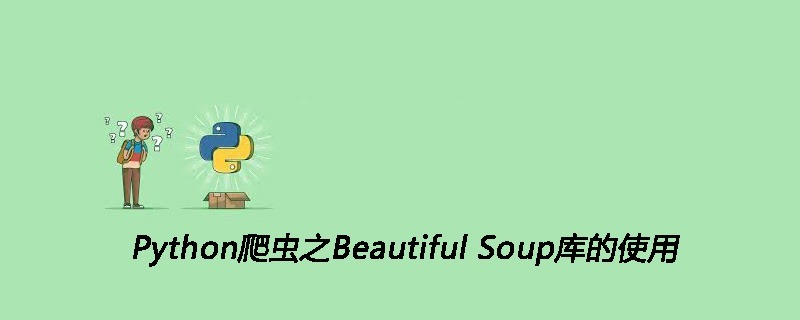Beautiful Soup是一个可以从HTML或XML文件中提取数据的Python库。它能够通过你喜欢的转换器实现惯用的文档导航,查找,修改文档的方式。Beautiful Soup 会帮你节省数小时甚至数天的工作时间。

1. 安装
以下都是在 python2.7 中进行测试的。
可以直接使用 pip 安装:
$ pip install beautifulsoup4
BeautifulSoup 不仅支持 HTML 解析器,还支持一些第三方的解析器,如,lxml,XML,html5lib 但是需要安装相应的库。
$ pip install lxml $ pip install html5lib
2. 开始使用
Beautiful Soup 的功能相当强大,但我们只介绍经常使用的功能。
简单用法
将一段文档传入 BeautifulSoup 的构造方法,就能得到一个文档的对象, 可以传入一段字符串或一个文件句柄。
>>> from bs4 import BeautifulSoup
>>> soup = BeautifulSoup("<html><body><p>data</p></body></html>")
>>> soup
<html><body><p>data</p></body></html>
>>> soup('p')
[<p>data</p>]
首先传入一个 html 文档,soup 是获得文档的对象。然后,文档被转换成 Unicode ,并且 HTML 的实例都被转换成 Unicode 编码。然后,Beautiful Soup 选择最合适的解析器来解析这段文档,如果手动指定解析器那么 Beautiful Soup 会选择指定的解析器来解析文档。但是一般最好手动指定解析器,并且使用 requests 与 BeautifulSoup 结合使用, requests 是用于爬取网页源码的一个库,此处不再介绍,requests 更多用法请参考 Requests 2.10.0 文档 。
要解析的文档是什么类型: 目前支持, html, xml, 和 html5
指定使用哪种解析器: 目前支持, lxml, html5lib, 和 html.parser
from bs4 import BeautifulSoup
import requests
html = requests.get(‘http://www.jianshu.com/’).content
soup = BeautifulSoup(html, 'html.parser', from_encoding='utf-8')
result = soup('div')
对象的种类
Beautiful Soup 将复杂 HTML 文档转换成一个复杂的树形结构,每个节点都是 Python 对象,所有对象可以归纳为 4 种: Tag , NavigableString , BeautifulSoup , Comment。
Tag:通俗点讲就是 HTML 中的一个个标签,像上面的 div,p。每个 Tag 有两个重要的属性 name 和 attrs,name 指标签的名字或者 tag 本身的 name,attrs 通常指一个标签的 class。
NavigableString:获取标签内部的文字,如,soup.p.string。
BeautifulSoup:表示一个文档的全部内容。
Comment:Comment 对象是一个特殊类型的 NavigableString 对象,其输出的内容不包括注释符号。
示例
下面是一个示例,带你了解 Beautiful Soup 的常见用法:
import sys
reload(sys)
sys.setdefaultencoding('utf-8')
from bs4 import BeautifulSoup
import requests
html_doc = """
<head>
<meta charset="utf-8">
<meta http-equiv="X-UA-Compatible" content="IE=Edge">
<title>首页 - 简书</title>
</head>
<body class="output fluid zh cn win reader-day-mode reader-font2 " data-js-module="recommendation" data-locale="zh-CN">
<ul class="article-list thumbnails">
<li class=have-img>
<a class="wrap-img" href="/p/49c4728c3ab2"><img src="http://upload-images.jianshu.io/upload_images
/2442470-745c6471c6f8258c.jpg?imageMogr2/auto-orient/strip%7CimageView2/1/w/300/h/300" alt="300" /></a>
<div>
<p class="list-top">
<a class="author-name blue-link" target="_blank" href="/users/0af6b163b687">阿随向前冲</a>
<em>·</em>
<span class="time" data-shared-at="2016-07-27T07:03:54+08:00"></span>
</p>
<h4 class="title"><a target="_blank" href="/p/49c4728c3ab2"> 只装了这六款软件,
工作就高效到有时间逛某宝刷某圈</a></h4>
<div class="list-footer">
<a target="_blank" href="/p/49c4728c3ab2">
阅读 1830
</a> <a target="_blank" href="/p/49c4728c3ab2#comments">
· 评论 35
</a> <span> · 喜欢 95</span>
<span> · 打赏 1</span>
</div>
</div>
</li>
</ul>
</body>
"""
soup = BeautifulSoup(html_doc, 'html.parser', from_encoding='utf-8')
# 查找所有有关的节点
tags = soup.find_all('li', class_="have-img")
for tag in tags:
image = tag.img['src']
article_user = tag.p.a.get_text()
article_user_url = tag.p.a['href']
created = tag.p.span['data-shared-at']
article_url = tag.h4.a['href']
# 可以在查找的 tag 下继续使用 find_all()
tag_span = tag.div.div.find_all('span')
likes = tag_span[0].get_text(strip=True)
BeautifulSoup 主要用来遍历子节点及子节点的属性,通过点取属性的方式只能获得当前文档中的第一个 tag,例如,soup.li。如果想要得到所有的<li> 标签,或是通过名字得到比一个 tag 更多的内容的时候,就需要用到 find_all(),find_all() 方法搜索当前 tag 的所有 tag 子节点,并判断是否符合过滤器的条件find_all() 所接受的参数如下:
find_all( name , attrs , recursive , string , **kwargs )
按 name 搜索: name 参数可以查找所有名字为 name 的 tag,字符串对象会被自动忽略掉:
soup.find_all("li")
按 id 搜索: 如果包含一个名字为 id 的参数,搜索时会把该参数当作指定名字 tag 的属性来搜索:
soup.find_all(id='link2')
按 attr 搜索:有些 tag 属性在搜索不能使用,比如 HTML5 中的 data-* 属性,但是可以通过 find_all() 方法的 attrs 参数定义一个字典参数来搜索包含特殊属性的 tag:
data_soup.find_all(attrs={"data-foo": "value"})
按 CSS 搜索: 按照 CSS 类名搜索 tag 的功能非常实用,但标识CSS 类名的关键字 class 在 Python 中是保留字,使用 class 做参数会导致语法错误.从 Beautiful Soup 的 4.1.1 版本开始,可以通过 class_ 参数搜索有指定 CSS 类名的 tag:
soup.find_all('li', class_="have-img")
string 参数:通过 string 参数可以搜搜文档中的字符串内容.与 name 参数的可选值一样, string 参数接受 字符串 , 正则表达式 , 列表, True 。 看例子:
soup.find_all("a", string="Elsie")
recursive 参数:调用 tag 的 find_all() 方法时,Beautiful Soup 会检索当前 tag 的所有子孙节点,如果只想搜索 tag 的直接子节点,可以使用参数 recursive=False .
soup.find_all("title", recursive=False)
find_all() 几乎是 Beautiful Soup中最常用的搜索方法,也可以使用其简写方法,以下代码等价:
soup.find_all("a")
soup("a")
get_text()
如果只想得到 tag 中包含的文本内容,那么可以用 get_text() 方法,这个方法获取到 tag 中包含的所有文版内容包括子孙 tag 中的内容,并将结果作为 Unicode 字符串返回:
tag.p.a.get_text()
神龙|纯净稳定代理IP免费测试>>>>>>>>天启|企业级代理IP免费测试>>>>>>>>IPIPGO|全球住宅代理IP免费测试




































